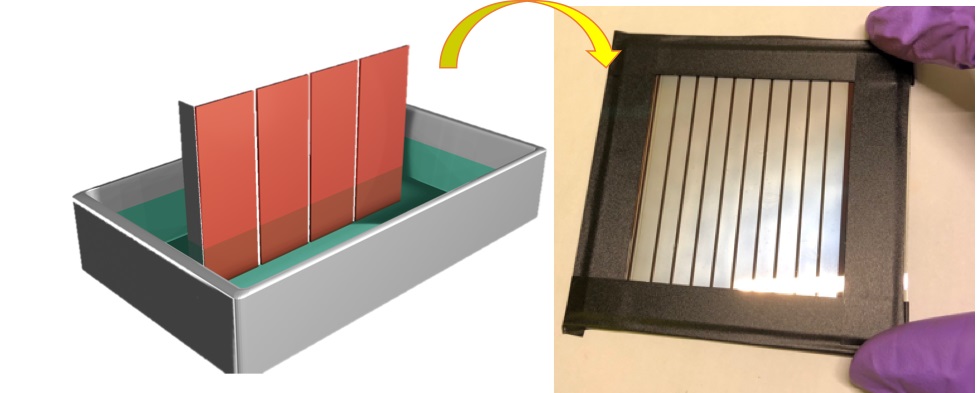A simple, synthetic process for fabricating stable perovskite solar cells has overcome a preventative challenge to large-scale production, and, as a result, to product commercialization. A team from Los Alamos National Laboratory and National Taiwan University developed a one-step spin coating method using a liquid solvent called sulfolane that enabled it to produce high-yield, large-area photovoltaic devices that are efficient in solar power generation and possess a long operational lifetime.
The researchers used an additive in the perovskite precursor, the liquid material that creates perovskite crystals through chemical reaction.

A new dipping process (left) using a sulfolane additive creates high-performing perovskite solar cells. The method is inexpensive and well suited for scaling up to commercial production. Courtesy of Los Alamos National Laboratory.
Perovskite photovoltaics have been seen as the potential successor to silicon-based photovoltaics for decades. Commercialization of the technology has been halted by the inability to realize pathways to large-scale production.
One of the major roadblocks to large-scale production is in the narrow processing period, or the time during which the film can be laid down on substrate. To get a uniform crystalline film that is well bonded to the layer below, the deposition process has to be strictly controlled and carried out in seconds.
The proposed method introduces sulfolane as an additive during the liquid stage of the process, before the chemical reaction that creates the perovskite crystals. The additive extends the processing window from 9 to 90 s.
Through a simple dipping method, the team was able to deposit a uniform, high-quality perovskite crystalline thin film covering a large active area in two minimodules — one of about 16 sq cm and the other nearly 37 sq cm. The minimodules achieved a power conversion efficiency of 17.58% and 16.06%, respectively. The sulfolane additive uniformly formed highly crystalline and compact layers; that uniformity and even distribution is essential to device performance.
“Our work paves the way for low-cost, high-throughput, commercial-scale production of large-scale solar modules in the near future,” said Wanyi Nie, corresponding author and research scientist fellow in the Center for Integrated Nanotechnologies at Los Alamos. “We were able to demonstrate the approach through two minimodules that reached champion levels of converting sunlight to power with greatly extended operational lifetimes. Because this process is facile and low cost, we believe it can be easily adapted to scalable fabrication in industrial settings.”
The research was published in Joule (www.doi.org/10.1016/j.joule.2021.02.012).